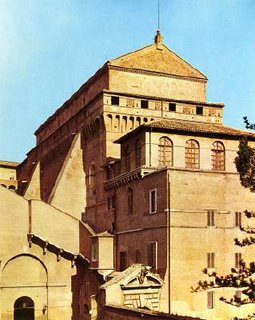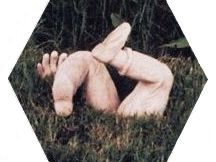Wednesday, December 13, 2006
Posted by alilbit at 5:51 AM 0 comments
Monday, December 11, 2006
Remarkable History And Photos

THE SISTINE CHAPEL.This tour guides you through the Sistine Chapel in the Vatican.The Sistine Chapel was built between 1475 and 1483, in the time of Pope Sixtus IV. Its basic feature is the papal function, as the pope's chapel and the location of the elections of new popes. The architectural plans for the chapel were made by Baccio Pontelli and the construction was supervised by Giovannino de'Dolci.In 1481 Pope Sixtus IV summoned to Rome the Florentine painters Sandro Botticelli, Domenico Ghirlandaio and Cosimo Rosselli, as well as the Perugian Pietro Perugino to decorate the walls with frescoes. Michelangelo was commissioned by Pope Julius II della Rovere in 1508 to repaint the ceiling. The work was completed between 1508 and 1512. He painted the Last Judgement over the altar, between 1535 and 1541, being commissioned by Pope Paul III.
Posted by alilbit at 5:04 AM 0 comments
Sunday, December 10, 2006
Random Stuff

The construction site at the Golden Gate Bridge was America's first designated hard-hat area.
Contrary to the traditional image of the helpful female switchboard operator, the original telephone operators were young boys, who held a reputation for their rudeness and inefficiency.
Of all the capital cities in the world, the one least likely to suffer from major fire damage is La Paz, Bolivia due to the scarcity of oxygen at its 12,000-foot elevation.
For the 1944 Highway Construction Act, Congress proposed the creation of roadside landing strips in anticipation of the postwar surge in flying cars.
A company based in eastern Canada bottles water, beer and vodka all made from harvested icebergs, thousands of years old.
The shipwreck of a vessel sunken in the Baltic Sea during World War I was discovered to contain drinkable bottles of sparkling wine, many of which were sold at Christie's for upwards of 2,200 pounds, or approximately $3,000.
The "one if by land, two if by sea" lanterns used to warn of approaching British were not a signal to Paul Revere, but a signal from him, used as a backup in case either he or William Dawes (the unsung rider) couldn't make it out of Boston.
Believe it or Not's Robert Ripley pointed out that despite popular belief, the United States' national anthem was not The Star-Spangled Banner, nor any other song; The Star-Spangled Banner had been turned down six times as America's anthem and it wasn't until Ripley brought up the subject did citizens write thousands of protest letters, forcing Congress to make it official in 1931.
The large crack in America's famous Liberty Bell was originally a mere hairline fracture that was deliberately drilled into a larger gap so it could be fastened with pins for retuning.
After being illuminated with ultraviolet light, many artificially grown diamonds will glow in the dark.
Posted by alilbit at 2:48 PM 0 comments
Trivia

Rhode Island was the first state to require a driver's test.
William Randolph Hearst had hired Adolf Hitler to write opinion columns for his newspaper, but fired him for continually missing his deadlines.
For a time, Walt Whitman's brain resided at the Wistar Institute, a University of Pennsylvania facility, although it was reportedly discarded after a research assistant dropped it.
The white space between the capital E and the lowercase X in the FedEx logo forms a little arrow.
Alexander the Great was embalmed in honey.
Kleenex tissues were originally developed as gas-mask filters during World War I.
The first message transmitted over the Internet (then known as ARPANet) was "LOGIN," although on the first try, it crashed on the G.
The world's largest known pyramid is not in Egypt; it is the Great White Pyramid in China.
Due to years of unregulated oil dumping, Ohio's Cuyahoga River became a combustible waterway that ignited four times — in 1949, 1951, 1952 and 1969.
Surprisingly, the first Mickey Mouse cartoon was not the much-celebrated "Steamboat Willie," but rather a short titled "Plane Crazy," penned by Walt Disney's partner Ub Iwerks. The second was "Galloping Gaucho." "Steamboat Willie" appeared third, but was the first to use synchronized sound.
Posted by alilbit at 2:44 PM 0 comments
Cats Sure Are Smart These Days

This reminds me of Steve Martin discussing the horrors of cat juggling in The Jerk. Apparently someone found cats walking on keyboards a big enough problem to create a program that could detect “Cat-like typing”. When the program detects a cat walking across the keyboard it locks the keyboard functions and makes an annoying noise over the computer speakers to scare the cat away. There’s even a helpful Q&A on the site, addressing questions like “What if my cat is deaf?” with part of the answer being “PawSense detects the paws of even deaf cats.” That’s brilliant.
Posted by alilbit at 2:35 PM 0 comments
How Dickens Saved Christmas


Back in the day — the 16th and 17th centuries, that is — Christmas was less about goodwill towards men, and more about letting off steam. While there were certainly carols sung, gifts given and feasts consumed, there was also lots of drinking, gambling and promiscuity. Disapproving Puritans pointed to the traditional (and traditionally bawdy) pagan winter celebrations of Saturnalia and Yule, and accused modern revelers of carrying over pagan bad habits. (They also referred to the Christmas celebration as “the trappings of Popery” and “rags of the beast.”)
Such criticism led to the Catholic Church promoting Christmas in a more religiously-oriented way (rather than as an annual safety valve/opportunity for the oppressed underclasses to get their freak on), but that wasn’t enough for Protestants, who banned Christmas in 1647 when Puritan rulers succeeded King Charles I after the English Civil War. Subsequently, furious pro-Christmas rioting broke out in several English cities, including Canterbury, which was controlled by mobs for weeks. (Not as scary as it sounds, perhaps — they mostly just chanted royalist slogans and decorated things with holly.) The Restoration of 1660 ended Puritan rule and the English ban on Christmas.
Puritans in the New World brought their ban with them, so in heavily Puritan Boston Christmas wasn’t celebrated between 1659 and 1681 (though Virginians and New Yorkers kept the party going). After the American Revolution, Christmas was seen as an English tradition and fell out of favor in the states. Meanwhile in England, Christmas seemed to be fading out along with the religious and sectarian tensions that had shaped much of its history.
So what got Christmas going again? While we can’t give Charles Dickens all the credit, the immense popularity of A Christmas Carol had a lot to do with it — on both sides of the Atlantic. The book played a major role in reinventing Christmas as a holiday emphasizing family, goodwill, and compassion over communal celebration and hedonistic excess. In the US, short stories by Washington Irving depicting the English celebration of Christmas helped re-popularize it (this from the author of The Legend of Sleepy Hollow!) So this Christmas, raise a glass to Charles (a glass of decidedly non-bawdy, family-oriented drink) and thank him for the day.
Posted by alilbit at 2:29 PM 0 comments
Knocked Out Without Wind

I’ve fallen, and I can get up, but I can’t breathe!
Whether it was because the school bully socked you in the stomach really hard, or you jumped off the garage roof with parachute made from a bath towel (don’t ask), you’ve probably have had “the wind knocked out of you” at least once. What is this exactly, and why is it so painful?
Medical types call this phenomenon a “diaphragm spasm.” The diaphragm is a large, dome-shaped muscle located underneath your lungs. When you inhale, you’re actually constricting the diaphragm, which draws the lungs down and expands the rib cage. This action creates a temporary vacuum, which is what pulls air through your nose and down to your lungs. When you exhale, the diaphragm relaxes and the lungs deflate.
If you receive a good, hard blow to the solar plexus, it can temporarily paralyze the diaphragm. This can also empty all the air out of your lungs (probably accompanied by an audible “Ooooof!”) and send your diaphragm into a spasm. While the diaphragm remains paralyzed, your lungs can’t inflate and you are unable to breathe. The nerves around that area are sending intense pain messages to your brain, but all you want to do is catch your breath. A momentary sense of panic ensues. Luckily, you usually recover in a few moments, but the sensation scary enough to keep most kids off the garage roof a second time.
Posted by alilbit at 2:19 PM 0 comments





